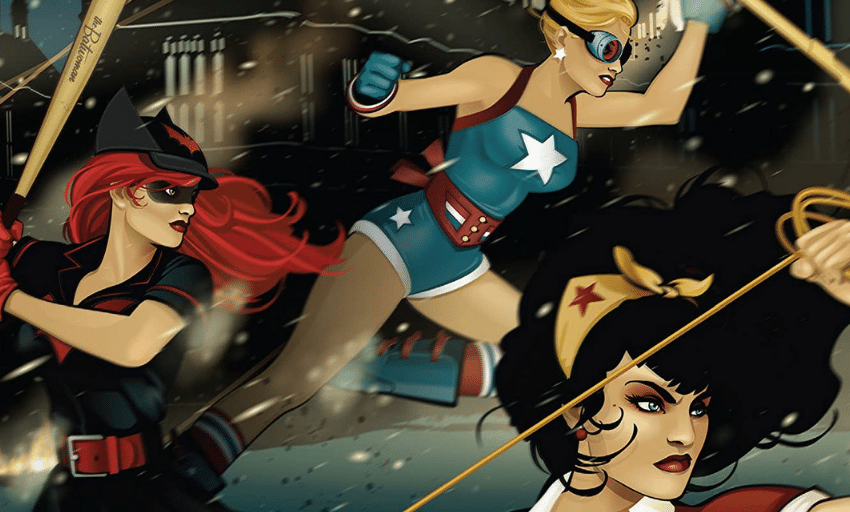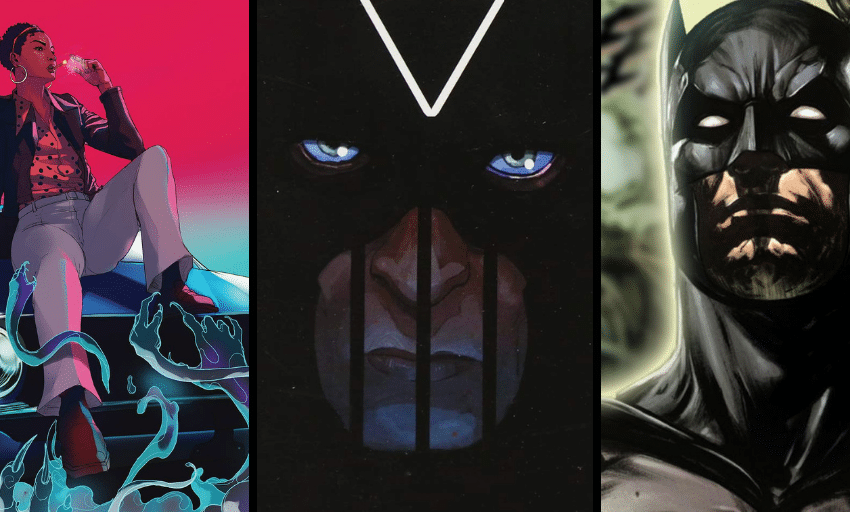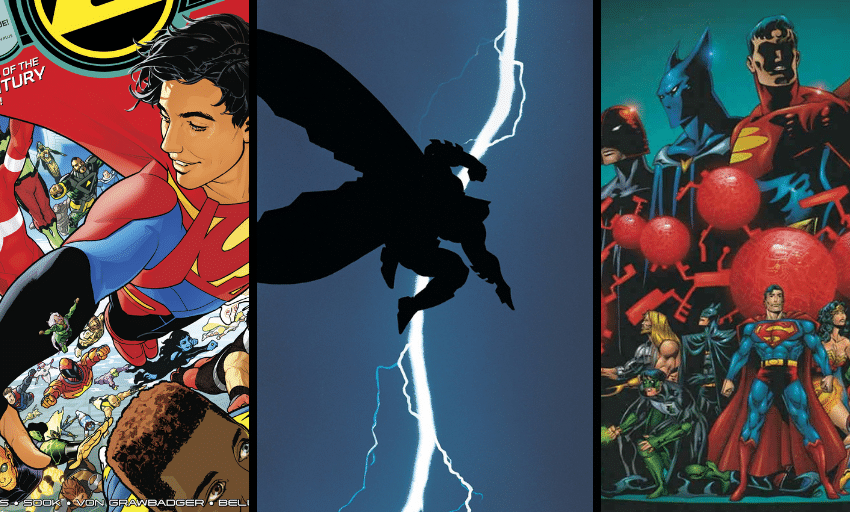It’s hard to be a Teen Titan when you’re celebrating a 40th anniversary, but they’ll keep trying.
Yes, this year marks the 40th anniversary of the definitive “New Teen Titans” run by Marv Wolfman and George Perez, a run that rivaled the X-Men at the height of its popularity. “New Teen Titans” helped define superheroes for the ’80s by introducing major DC characters like Cyborg, Starfire and Raven, evolving Dick Grayson from Robin to Nightwing and spending as much time with the personal soap opera of its heroes as it did with the superheroics.
This week, the Eisner Award-winning magazine Back Issue is doing an entire issue dedicated to the Titans, so I thought I’d toss my hat into the Titans discussion ring and talk about four of my favorite Titans stories by Wolfman and Perez that aren’t “The Judas Contract,” since that has been discussed and adapted all over the place, and one Titans story from the post-Wolfman/Perez years that, despite its flaws, has a special place in my heart.
A Day in the Lives… (New Teen Titans Vol. 1 #8)

For many X-Men fans, the issues where the characters are just having a regular day doing stuff around the X-mansion rank as some of the best issues. “X-Men” Vol. 2 #30, the wedding of Scott and Jean, is a favorite of mine, and “Uncanny X-Men” #308, where they get engaged and where the X-Men play football, is a favorite of editor extraordinaire Dan Grote. And while I’m sure other team books do something similar, it’s not all that common. But one of my favorite Titans issues is one of these stories.
After seven issues of fighting Trigon, Deathstroke and Dr. Light, the Titans have earned some down time. So throughout issue #8, we get vignettes of what each of the team does on their downtime. Starfire meets Wonder Girl at Donna’s fashion photography job and gets her first modeling gig, Cyborg, after hanging out with Changeling (Beast Boy’s codename at the time) and feeling down after his ex says she just can’t deal with all the changes to him, meets a group of kids with prostheses and learns he’s a hero to them. Kid Flash has a nice day with his parents. And Raven, free of Trigon for now, meditates, stops some terrorists and tests the lengths of her powers. All this while weird stuff with industrialists and puppets sets up the next arc.
One of the things that makes this issue so important is that, for readers, this was a big introduction to the inner lives of these characters. Cyborg, Raven and Starfire were less than a year old as characters at this point, and so this served as a way to get to know them. It also helped further establish the new status quos for Wonder Girl, Changeling and Kid Flash, who weren’t as well known as Robin, who has a much smaller role in this issue. The issue also expands the Titans’ supporting cast, as it introduces Sarah Simms, the teacher at the School for the Handicapped who would become Cyborg’s maybe/kinda/sorta love interest for some time, and also Terry Long, Donna Troy’s not-at-all-creepy college professor boyfriend.
Fun fact: Issue #8 was the quiet issue for a bunch of DC’s best regarded team books of the ’80s. Both “Justice League International” and “Suicide Squad” also had character-centric issue eights.
Titans vs. the Brotherhood of Evil (New Teen Titans Vol. 1 #13-15)

When readers were introduced to Changeling, now best known by his original codename of Beast Boy, at the beginning of “New Teen Titans,” he seemed like the team’s jester. He was rich, always had a quip and was always flirting in that way that the ’80s thought was endearing and that we now look at as borderline if not complete harassment. But under that bluster was a broken heart, someone who had lost family, and had rage to spare, which would come to the fore when the Titans confront the killers of his previous team, the Doom Patrol, and most importantly to him his adoptive mother Rita Farr, the Doom Patrol member known as Elasti-Girl.
The story starts with Robin, Kid Flash and Cyborg following up on a lead to find Changeling’s adoptive father, former Doom Patrol member Steve Dayton, who is hunting the Brotherhood of Evil, who killed the Doom Patrol while Changeling was convalescing from wounds inflicted in a battle with Deathstroke. They find Dayton, as well as the (at that point) lone survivor of the Doom Patrol’s final battle, Robotman, in a jungle near one of the Brotherhood’s bases. They are able to collect Dayton and Robotman, and wait for the rest of the Titans to arrive.
With Changeling’s arrival, the story kicks into high gear. Dayton, whose mind had been affected by the Brotherhood, attacks the Titans and is defeated, and the Titans find that the Brotherhood base is actually a flying city, which lifts off to attack the newly created-for-the-comics Baltic nation of Zandia, which would become a major locale for Titans stories moving forward. A final battle takes place in the flying city, with Beast Boy hunting down Madame Rouge, whom he blames for the deaths of the Doom Patrol, with the intention of killing her. In the end, he realizes killing her would make him no better than she, and while Rouge does die, it is not at his hands. Changeling is able to move past the deaths of the Doom Patrol and grow up.
Now, unfortunately, that growing up doesn’t entirely stick, because this is comics, but the story gives some great emotional beats for Changeling. It also is full of great action set pieces straight out of ’80s action movies, with jungle lairs, flying cities and a talking gorilla. Speaking of talking gorillas, the return of the Brotherhood of Evil is a great part of this arc. Yes, their name is ridiculous, but they are a group of villains with very distinct visuals, from classic members Monsieur Mallah and the Brain, to the new ones introduced here: Phobia, Houngan and Warp. These characters also give us a classic ’80s trope: phonetic accents that are so over-the-top ridiculous that they push past bad and circle around to parodically sublime. Mallah is a gorilla who speaks in a thick French accent. Where else other than comics are you going to get that?
Who is Donna Troy? (New Teen Titans Vol. 1 #38)

Similar to the first issue on this list, “Who is Donna Troy?” Is a quiet issue. But as opposed to the previous one, “New Teen Titans” #38 is much more focused, as it dives deep into two Titans: Wonder Girl and Robin.
For non-Titans fans, Wonder Girl’s history is a complete, giant and tremendous continuity mess. It only gets worse the longer the character is around, and it’s all Bob Haney’s fault. Haney, creator of the original Teen Titans team, was not exactly known for his adherence to continuity. And when he was building his teen team and wanted a girl, he figured he’d include Wonder Woman’s sidekick, Wonder Girl. Only Wonder Girl wasn’t Wonder Woman’s sidekick: She was a young Wonder Woman. So Haney accidentally created a new character and never bothered to give her an origin. Wolfman eventually wrote a backup story in the original “Teen Titans” series that gave Donna an origin, and he uses that as a springboard for this issue.
With Donna’s wedding to Terry Long approaching, Terry goes to Robin and asks him to investigate Donna’s past. She has little recollection of what her life was like before Wonder Woman brought her to Themyscira, and Terry wants her to know her past before moving into a future with him. What follows is a well-written investigation story. It’s not really a detective story, since there isn’t necessarily a crime, but Dick Grayson follows clues and tracks Donna’s history back to her adoptive parents and eventually to the secret of her birth mother.
The story, narrated by Dick, is an enjoyable piece of writing, but is at its heart a character study on both of its leads. It shows Dick’s intelligence, making it clear why he deserves his spot on the Titans. It also gives Donna closure on the great mystery of her past and delivers powerful emotional beats. And it finally answers the question of her origin … until “Crisis on Infinite Earths” completely blows that up, but hey, for now let’s just go with this as Donna’s origin.
Terror of Trigon (New Teen Titans Vol. 2 #1-5)

In the wake of “The Judas Contract,” “New Teen Titans” was more popular than ever, and so DC decided to add a second title. The original title was renamed “Tales of the Teen Titans,” while a new title, direct market only and on higher quality Baxter paper, was launched as “New Teen Titans” Vol. 2. Perez went to work on the new book and stayed on as regular penciller for just the first arc, which wrapped up the longest-running plot thread from the first series: Raven’s demonic father, Trigon.
Raven had been only a semi-Titan for some time, appearing occasionally while fighting the influence of Trigon. But at the start of this arc, she comes back, and Jericho, attempting to help her, instead forces Raven to trade herself for him, and Trigon is freed. Over the course of the arc, the Titans face their own darkness while fighting across a twisted and corrupted New York, and finally put an end to the threat of Trigon. Or for as long as a threat is ever ended in comics, you know?
This arc is probably only second to “The Judas Contract” in the annals of Titans stories. It features the entire classic team, with Wally West returning to help out, and adds in Jericho and Lilith for a stronger roster. It packs a pretty major emotional punch, as Raven struggles, succumbs and then redeems herself in battle with Trigon. While there are some plot holes, it wraps things up and gives the Titans a new direction. It also features Perez at the height of his powers. The Baxter paper shows off his art beautifully, and his vision of a Trigon-infected New York is terrifying.
Perez would return for one more arc as artist much later, and a series of other artists would follow, many of whom did excellent work. But this arc is the end of the Golden Age of “New Teen Titans” stories. The book never recaptured that breathless sense of wonder, or the perfect cohesion of art and story, that Wolfman and Perez had here. Also, whether it was intended at the time or not, the arc planted the seeds for the story that would usher the Titans into the ’90s.
Titans Hunt (New Titans #71-84)

If “Terror of Trigon” ends the Golden Age of the “New Teens Titans” era, then “Titans Hunt” is the story that sends the franchise into uncharted and dark territory that it never recovered from until, possibly, Geoff Johns came on the title in 2003. “Titans Hunt” is long, meandering, violent and, while not impenetrable, is a messy place to start reading Titans stories. So, of course it’s where I started.
”Titans Hunt” starts with the out-of-universe celebration of the Titans’ 10th anniversary, and the in-universe celebration of the team’s third. The first issue sees the entire team taken out, one by one, by Wildebeest, a fairly recent addition to the Titans’ rogues gallery. With most of the Titans kidnapped, and Nightwing seemingly dead, Steve Dayton hires Deathstroke, who was beginning his career as an anti-hero, to track down the Titans. And as with “The Judas Contract,” we get a Titans story with few Titans, only this time the story goes on for a year plus rather than four issues.
What follows is more than a year of stories where the Titans who had been the focus of the book for most of its run barely appear. Only NIghtwing, not really dead obviously, and Troia are members of this team, while the others remain captives of the Wildebeest Society; yes, it turns out there are a bunch of Wildebeests. Well, Cyborg is freed, too, but he has been seriously wounded and is now nearly all robot and has no personality, so … yeah. The rest of the team consists of Deathstroke; Raven’s mom, Arella; Red Star, the Russian hero who joins the team halfway through the arc; and new characters Pantha and Phantasm. On top of that, a whole new team of time-displaced Titans from the future, called the Team Titans, start appearing after the “Armageddon 2001” tie-in annual, and taking up pages, while having nothing to do with the “Titans Hunt,” which just makes it feel longer and throws off the rhythm of the story; basically picture “New Mutants” #1 being inserted into “Uncanny X-Men” right after Dark Phoenix flies off to eat a sun, and you get how jarring this is.
It’s not like “New Teen Titans” didn’t have long plots before: Brother Blood was a background threat for years, for instance. But this was the main plot, a major mystery, that kept getting interrupted by Team Titans or by crossovers: There’s another only semi-related issue that is a “War of the Gods” tie-in right before the climax. And because of the breakneck pace, the new characters are only somewhat fleshed out, so reader investment in them isn’t high.
The real kicker to this — and here be spoilers for a 30-year-old story — is that the leader of the Wildebeest Society is … Jericho. Corrupted by the essence of Trigon, the spirits of all of Azarath from the end of “The Terror of Trigon” have been controlling Jericho since they regained their strength sometime after that story. This is the second great Titans betrayal, after Terra, and would set up the “death” and corruption of Raven, who would be the big bad of the last couple years of the series. It’s a weird twist, and sets Jericho down the path to villainhood from the latter part of the post-Crisis era, which felt so out of character for the gentle hero he was before that.
After this arc, “New Titans” was never the same. The characters were distant from each other, and the soap opera got uglier. Within two years, the title got a whole new team, with most of the original Titans leaving, and what was once DC’s most popular title ended, with little fanfare, with issue #130. Still, while “Titans Hunt” remains a complete mess, I’ll always remember it fondly for introducing me to the Titans.
Matt Lazorwitz read his first comic at the age of five. It was Who's Who in the DC Universe #2, featuring characters whose names begin with B, which explains so much about his Batman obsession. He writes about comics he loves, and co-hosts the creator interview podcast WMQ&A with Dan Grote.






